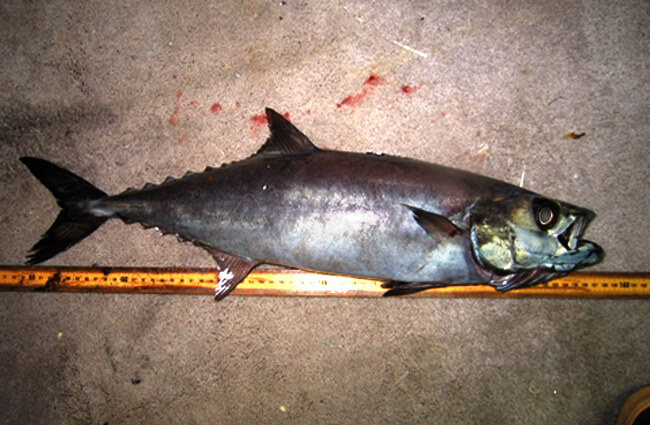The Enigmatic Escolar: A Deep-Sea Mystery with a Buttery Secret
Beneath the ocean’s sunlit surface, in the vast, dark expanse of the deep sea, dwells a creature of both intrigue and controversy: the Escolar. Known scientifically as Lepidocybium flavobrunneum, this formidable fish has captivated the attention of seafood enthusiasts, marine biologists, and even medical professionals. Its rich, buttery flavor makes it a prized catch, yet its unique physiology presents a fascinating challenge to those who consume it. Join us as we dive deep into the world of the Escolar, uncovering its secrets from its evolutionary past to its complex interactions with humans.

Unveiling the Escolar: Basic Biology and Identification
What is an Escolar?
The Escolar is a member of the Gempylidae family, commonly known as the snake mackerels. It is a large, predatory fish characterized by its sleek, elongated, and somewhat compressed body, which can reach impressive lengths of up to 2 meters (6.6 feet) and weigh over 45 kilograms (100 pounds). Its skin is typically a dark brown to black, often appearing metallic in certain lights, allowing it to blend seamlessly into the dim light of its deep-sea habitat. Distinctive features include large eyes, adapted for low-light conditions, and a formidable set of teeth, indicative of its predatory lifestyle. While sometimes mistakenly called “oilfish” or “butterfish” in commercial markets, these names often refer to other species, and the Escolar possesses its own unique biological characteristics that set it apart.

Where Does the Escolar Call Home?
The Escolar is a truly cosmopolitan deep-sea dweller, found in tropical and temperate waters across the globe. Its habitat spans the Atlantic, Pacific, and Indian Oceans, making it a truly widespread species. This benthopelagic fish typically inhabits depths ranging from 200 to 1100 meters (650 to 3600 feet), though it has been observed at even greater depths. During the day, Escolar tends to stay in deeper waters, ascending closer to the surface at night to feed. This vertical migration is a common strategy among deep-sea predators, allowing them to exploit different prey populations throughout the day-night cycle. For an animal lover hoping to spot an Escolar in the wild, it is important to understand that this is not a fish found in shallow coastal waters. Encounters are almost exclusively limited to deep-sea fishing operations or specialized submersible expeditions.
![Illustration of an EscolarPhoto by: Illustrations of the Zoology of South Africa [Public domain]](https://animals.net/wp-content/uploads/2020/01/Escolar-2-650x425.jpg)
Life in the Deep: Ecology and Behavior
The Escolar’s Menu: A Hunter of the Abyss
As an opportunistic and formidable predator, the Escolar plays a crucial role in the deep-sea food web. Its diet primarily consists of other fish, squid, and crustaceans. With its powerful jaws and sharp teeth, it is well-equipped to ambush and capture fast-moving prey in the low-light conditions of its environment. The Escolar’s large eyes are highly sensitive to faint light, aiding in the detection of bioluminescent prey or the silhouettes of other deep-sea inhabitants. Its torpedo-shaped body allows for bursts of speed, essential for successful hunting in the open ocean depths.
A Glimpse into Reproduction: The Mysteries of Escolar Mating
Details about the Escolar’s mating and reproduction process remain largely unknown, a common challenge when studying deep-sea species. Like many marine fish, it is believed to be an external broadcast spawner, meaning females release eggs and males release sperm into the water column, where fertilization occurs. The eggs and larvae are likely pelagic, drifting with ocean currents until they develop into juvenile fish capable of independent movement. Further research is needed to understand their spawning grounds, frequency, and the environmental cues that trigger reproduction, which are vital for a complete picture of their life cycle.
The Escolar’s Role in the Ecosystem
In its deep-sea habitat, the Escolar functions as an apex predator, helping to regulate populations of smaller fish, squid, and crustaceans. By preying on these organisms, it contributes to the overall health and balance of the deep-sea ecosystem. Its presence indicates a robust food web capable of sustaining large, active predators. While its direct interactions with other large marine animals are not extensively documented, it likely competes with other deep-sea predators for food resources and may occasionally fall prey to even larger oceanic hunters, though its size and depth range offer significant protection.
Escolar and Humanity: A Complex Relationship
The Culinary Conundrum: Taste, Mislabeling, and Health
The Escolar is highly valued in many culinary circles for its rich, buttery flavor and firm, white flesh. This desirable texture and taste are due to its exceptionally high oil content, specifically wax esters (gempylotoxin), which can constitute up to 25% of its body weight. Unfortunately, these wax esters are indigestible by humans. Consumption of Escolar, especially in large quantities, can lead to a condition known as keriorrhea or steatorrhea, characterized by oily, orange-colored diarrhea, abdominal cramps, nausea, and vomiting. These symptoms are generally unpleasant but not life-threatening and typically resolve within 24 to 48 hours.
Due to its appearance and texture, Escolar is frequently mislabeled and sold as “white tuna,” “butterfish,” or even “cod” in various markets and restaurants. This mislabeling poses a significant public health concern, as consumers may unknowingly ingest a fish that could cause digestive distress. Responsible consumption involves being aware of the fish’s identity, consuming it in very small portions (e.g., less than 6 ounces for an adult), and preparing it in ways that allow some of the oil to drain, such as grilling. Individuals with sensitive digestive systems or underlying health conditions should avoid Escolar entirely.
Fishing for Escolar: Bycatch and Commercial Value
Escolar is primarily caught as bycatch in fisheries targeting other deep-sea species, such as tuna and swordfish, using longline fishing methods. While not typically the primary target, its commercial value has increased due to demand for its unique flavor. The lack of specific fisheries for Escolar means its population dynamics are less studied than those of more commercially targeted species. This makes assessing its conservation status challenging, though it is not currently listed as endangered. Sustainable fishing practices and accurate labeling are crucial to ensure both the health of marine ecosystems and consumer safety.
Cultural Footprint: More Than Just a Fish
Beyond its biological significance, the Escolar has carved a niche in human culture, particularly within the culinary world. It represents a fascinating case study in food science and consumer awareness. Its presence in seafood markets sparks discussions about food safety, species identification, and the ethics of mislabeling. For many chefs, it is a delicacy to be prepared with caution and respect, while for public health advocates, it highlights the need for transparency in the seafood industry. Its story is a testament to the intricate relationship between humans and the ocean’s bounty, reminding us that even the most delicious offerings can come with a unique set of considerations.
For the Aspiring Zoologist and Deep-Sea Enthusiast
Evolutionary Journey: A Deep-Sea Adaptation Story
The Escolar’s evolutionary history is deeply intertwined with its adaptation to the deep-sea environment. As a member of the Gempylidae family, it shares common ancestry with other snake mackerels, all characterized by their elongated bodies and predatory habits. Over millennia, Escolar developed specific adaptations for life in the mesopelagic and bathypelagic zones. These include its large, light-sensitive eyes for navigating perpetual twilight, its robust musculature for powerful swimming, and its unique digestive system that processes the high-fat diet of deep-sea prey, leading to the accumulation of indigestible wax esters. Studying the Escolar provides valuable insights into the physiological and morphological changes required for survival in one of Earth’s most extreme habitats.
Encountering Escolar in the Wild: A Rare Sight
For an animal lover or aspiring zoologist hoping to find an Escolar in its natural habitat, it is important to manage expectations. Given its deep-sea dwelling nature, encountering an Escolar is an exceedingly rare event for anyone not involved in deep-sea research or commercial fishing. It is not a fish one would typically find while snorkeling, diving recreationally, or even on a casual boat trip. If, by some extraordinary chance, a deep-sea hiker or explorer were to encounter an Escolar (perhaps a deceased specimen washed ashore, though highly unlikely for a deep-sea fish), the recommended action would be to observe from a respectful distance, avoid direct contact, and report the sighting to local marine biology institutions or wildlife authorities. Never attempt to handle or consume an unknown deep-sea fish.
Caring for Escolar in Captivity: A Zookeeper’s Challenge
Keeping an Escolar in captivity presents immense challenges, making it an extremely rare, if not unheard of, occurrence in public aquariums. Its deep-sea habitat requires highly specialized conditions that are difficult and expensive to replicate. For a hypothetical zookeeper tasked with caring for an Escolar, the primary focus would be on simulating its natural environment as closely as possible:
- Temperature and Pressure: Maintaining consistently cold temperatures (typically 4-10°C or 39-50°F) and immense hydrostatic pressure would be paramount. This would necessitate a specialized, pressure-controlled deep-sea exhibit, a technology still in its infancy for large animals.
- Light Conditions: The exhibit would need to mimic the perpetual twilight or complete darkness of its natural depth, with minimal artificial lighting.
- Diet: A diet rich in deep-sea fish, squid, and crustaceans would be essential, provided in a manner that encourages natural hunting behaviors.
- Water Quality: Pristine water quality, with specific salinity and oxygen levels, would be crucial.
- Space: Given its size and active predatory nature, a very large, open tank would be required to allow for adequate swimming space and to reduce stress.
- Health Monitoring: Regular monitoring for signs of stress, nutritional deficiencies, or disease would be vital. Special attention might be paid to its unique lipid metabolism, though specific captive care protocols for this are not established.
Tasks to avoid would include sudden changes in environmental conditions, overfeeding (especially with high-fat items that could exacerbate its natural oil content), and any handling that could cause physical or psychological stress. The sheer difficulty means Escolar is best left in its natural, deep-sea home.
Fascinating Facts About Escolar
- The scientific name Lepidocybium flavobrunneum roughly translates to “scaly-headed yellow-brown fish,” though its common appearance is dark.
- Its large eyes are an adaptation to detect faint light in the deep ocean, where sunlight penetrates only the uppermost layers.
- Escolar is sometimes referred to as “snake mackerel” due to its elongated body shape, reminiscent of a snake.
- The wax esters in Escolar are similar to those found in jojoba oil, which is used in cosmetics.
- Despite its potential digestive effects, Escolar is considered a delicacy in many parts of the world, particularly in Asia.
- It is a solitary hunter, preferring to patrol the deep waters alone rather than in schools.
- The Escolar’s powerful swimming ability allows it to undertake significant vertical migrations daily.
- Its flesh is so oily that it can sometimes feel greasy to the touch even after cooking.
- Some cultures have traditional methods of preparing Escolar that aim to reduce its oil content, such as salting or drying.
Conclusion: Respecting the Deep-Sea Dweller
The Escolar stands as a remarkable testament to life’s adaptability in the deep ocean. From its predatory prowess in the abyssal plains to its controversial presence on dinner plates, this fish offers a wealth of knowledge for students, zoologists, and curious minds alike. Its story underscores the importance of understanding marine biodiversity, the complexities of our food systems, and the need for responsible interaction with the natural world. As we continue to explore the mysteries of the deep, the Escolar reminds us that every creature, no matter how obscure or challenging, plays a vital role in the intricate tapestry of life on Earth.

![Red Angus Closeup of a beautiful Red Angus cowPhoto by: U.S. Department of Agriculture [pubic domain]https://creativecommons.org/licenses/by/2.0/](https://animals.net/wp-content/uploads/2020/03/Red-Angus-4-238x178.jpg)




![Red Angus Closeup of a beautiful Red Angus cowPhoto by: U.S. Department of Agriculture [pubic domain]https://creativecommons.org/licenses/by/2.0/](https://animals.net/wp-content/uploads/2020/03/Red-Angus-4-100x75.jpg)

